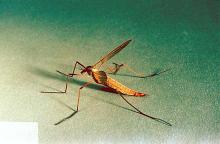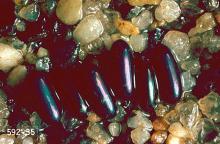Tipula paludosa
Pest description and crop damage Larvae are called leatherjackets because of the leathery appearance of the cuticle. They feed on roots and underground rhizomes from fall through spring months. In western Oregon, T. paludosa larvae feed on and topple upright stems in April and May. In the Columbia Basin, large populations of the larvae of Nephrotoma ferruginea, have been noticed in late October and November feeding on small roots.
Note: It is questionable whether spring damage to stems by T. paludosa justifies insecticide application.
Biology and life history Adult T. paludosa emerge from overwintering third-instar larvae from late July through October. Upon emergence, adults do not feed but instead quickly mate and begin laying eggs for 2 to 14 days. Often described as a large mosquito, cranefly adults are approximately 1 inch in length with long wings and legs. Oviposition sites are typically moist soil areas to protect eggs from desiccation prior to hatching in about 14 days. Larvae can be found in the soil profile from October through June. Following the overwintering period in the third instar, larvae molt to the fourth instar in April and feed before pupation in July and August. This species has one generation per year.
Scouting and thresholds Look for the large adults of T. paludosa flying in fields in August and September. Take soil samples and screen soil to a depth of 2 to 4 inches from mid to late October through June in order to determine larval populations. In spring, look for clipped uprights and locate larvae in soil nearby. Larval numbers in excess of 10 per sq ft may injure mint.
Management-chemical control
No insecticides are registered.




